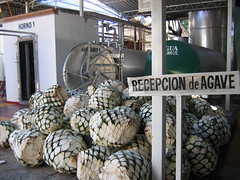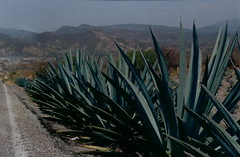Tequila, er, agave, the new superfood?
People in Jalisco like to promote tequila as a bit of a cure-all. And yes, a shot of tequila is always difficult to turn down. (What is it Homer Simpson once said? To alcohol, the cause and solution of all of life's problems?)
But on a more serious note, researchers at the University of Guadalajara are finding the most useful compounds in the agave plant. (Tequila is made from the roasted agave hearts.) Agave is full of inulin, and miel de agave (agave syrup) supposedly contains a sugar profile that's okay for diabetics. Now agave apparently could help deliver drugs into the intestine. Agave compounds can apparently survive stomach acids that destroy most drugs.
Look for more agave products to appear on health food store shelves in the meantime. As for miel de agave, it doesn't do anything for me, but that's a personal preference. I'll certainly keep drinking tequila, though - Cazadores reposado straight up is a favorite.
But on a more serious note, researchers at the University of Guadalajara are finding the most useful compounds in the agave plant. (Tequila is made from the roasted agave hearts.) Agave is full of inulin, and miel de agave (agave syrup) supposedly contains a sugar profile that's okay for diabetics. Now agave apparently could help deliver drugs into the intestine. Agave compounds can apparently survive stomach acids that destroy most drugs.
Look for more agave products to appear on health food store shelves in the meantime. As for miel de agave, it doesn't do anything for me, but that's a personal preference. I'll certainly keep drinking tequila, though - Cazadores reposado straight up is a favorite.



